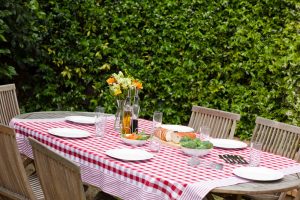Options for Your Outdoor Living Space: Deck, Concrete and Pavers
August 10th, 2017 | Posted in Backyard, Design Tips, Home Building, Outdoor Living Spaces There are a number of choices to consider for your outdoor living area and all have advantages and disadvantages. We will review three options, deck, concrete, and pavers, so you can decide which is the best choice for you.
There are a number of choices to consider for your outdoor living area and all have advantages and disadvantages. We will review three options, deck, concrete, and pavers, so you can decide which is the best choice for you.
The least expensive option for your outdoor living area is a standard concrete patio. This would be the typical grey colored concrete. A standard concrete patio does not require much maintenance at all. You may decide to pressure wash it occasionally or apply a waterproofing sealer but if you do nothing it will serve its purpose. It’s a very utilitarian option, not very attractive or colorful.
A stamped concrete patio puts a pattern and color into the concrete. This dramatically improves the appearance of the concrete patio. The color and pattern also increases the cost of the patio substantially over a standard grey concrete patio. Stamped concrete patios do require frequent sealing to keep up their appearance. If not sealed every couple of years, the color will become dramatically duller. Also, be careful to choose a sealer that is compatible with any sealer already applied to the stamped concrete, otherwise you may experience the dreaded fogging or turning white that can happen with incompatible sealers.
Both standard and stamped concrete patios are subject to cracking. A good gravel base below the concrete slab is essential to minimizing cracks. All concrete cracks. Cracks are unavoidable. Cracks can be minimized with a good base and proper saw cutting or control jointing of the slab.
A paver patio is typically a little more expensive than stamped concrete. The choice of paver can dramatically affect the cost. The advantages of the pavers are that you do not get cracking like concrete. A proper base is essential to prevent settling, but if you do experience some settling the individual pavers can be removed, leveled and replaced. In the past, a big disadvantage of these patios was the sand between the pavers. Weeds would grow in the sand and the sand would wash away. But, with today’s polymeric sand, which hardens like concrete, these issues have been eliminated. Brick or paver patios can be sealed to prevent staining and fading but can also be left natural. Consult your installer for sealing options or requirements based on the specific paver you choose.
A concrete or paver patio would typically be at grade. You would need to build steps to get down to it from your house’s door. These steps could be made out of wood, composite decking, concrete or pavers. If you use concrete or paver steps you may need to install a footer under the steps to keep the patio from settling due to the weight of the steps on the patio. Alternatively, you could install a retaining wall and elevate the patio so you do not need steps but this can get quite expensive with the cost of the retaining wall and the gravel or sand fill you need to bring up the grade within the retaining wall. Also with patios, a level rear yard is easiest. If your yard slopes, you may need a retaining wall to create a level surface for the patio. This can add significant expense to the project.
With concrete or paver patios a good base of virgin ground below the patio is essential. For new construction, the backfill against the house will typically settle in the first couple years. This will lead to an uneven patio. The solution is to have the builder backfill the area where the patio will go with gravel. This can add up to a few thousand dollars in gravel costs to the project depending on the size of the patio.
A wooden deck is another option for your outdoor living area. The big disadvantage of a wooden deck is the frequent pressure washing and sealing you need to do to keep it looking good. Without sealing it will turn grey and crack and splinter. The cost of a wooden deck install may seem attractive initially, but the maintenance costs over time are substantial.
A composite or plastic deck eliminates the sealing, cracking and splintering of a wooden deck but they are not maintenance free. They do require cleaning to keep them looking nice. Make sure to pick a product that deters mold or fungus growth. Also, be cautious of using dark colors. Dark decking boards will be very hot on a sunny day. You may not be able to walk on them bare foot. Composite or plastic decks can be very, very expensive due to the costs of the materials.
A deck is the superior option for any type of elevated situation. This would be when your home has a walkout basement below the area you want the outdoor living area or if your yard is not level. The post and beam framing of the deck makes the cost much less than trying to install retaining walls to elevate a patio.
Take time and examine your property to determine which outdoor living area works best. Ultimately, you will weigh the pros and cons of each and make the best choice for you.

